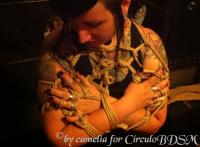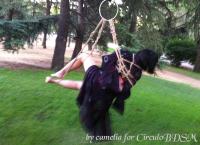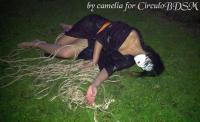Copyright 2011 by Haru Tsubaki. All rights reserved. No part of this publication may be reproduced, distributed, or transmitted in any form or by any means, including photocopying, recording, or other electronic or mechanical methods, without the prior written permission of the publisher
Every person who has been lucky enough to have the opportunity to visit Japan, may have noticed that courtesy and refinement are distinguished characteristics of every Japanese tradition or ritual. However courtesy can turn into a meagre virtue if practised only to avoid being impolite. In fact it should be the external manifestation of a true understanding consideration for everybody else’s feelings
In its purest and enlightened form, without being stained by hypocrisy, courtesy is very close to love. We can proudly say that courtesy “suffereth long, and is kind; envieth not, vaunteth not itself, is not puffed up; doth not behave itself unseemly, seeketh not her own, is not easily provoked, taketh not account of evil“.(*)
(*) From the book “Bushido: The Soul of Japan” by Nitobe Inazō
Even when we already said in the past article: Shibari Kinbaku as a Ritual:Protocol for viewers and models (Part I), that certain Shibari Kinbaku basis had a high relation with Samurais legendary lives and their strong honour code Bushido, we can also say that its execution and the ritual between rigger and model may have a better relation to Kabuki (Japanese traditional theatre art) than with Hojojutsu (Samurai’s martial art). In Shibari/Kinbaku sessions ropes are used without the purpose of hurting the other. It’s more like a dramatization where the show is a highly sensual situation, where pain is administered in a controlled way and with the clear purpose of erotically stimulate both the model and the audience.
It’s because of this fact that the energy flow and sensation’s exchange between riggers and models is so crucial, and is the very essence of Shibari/Kinbaku practice. In order to protect and care this energy flow, to avoid it being interrupted or being damaged by inadvertent actions from any of the parts, is that I’ve wanted to quote and write some good practices to be kept in mind both from rigger and model’s side.
“It’s always better to prevent”
* Neither the rigger nor the model should were any kind of bangles, bracelets, watches, etc. Those kind of elements could cause problems or unexpected damages during the session.
* Neither the rigger nor the model should be chewing gum or eating candies during the session. These kind of products may cause serious problems during a suspension, for example.
* Neither the rigger nor the model should have consumed alcohol or any kind of substances that may impair their sensations during the session or even in the moments before it.
* The rigger should get acquainted with his model’s health both physical and mental before the session. Certain warnings may be and not limited to asthma, breathing problems, circulatory problems, heart condition, diabetes, hypertension, hypotension, allergic issues to the rope material, capillary fragility, inflammatory joint conditions (as the carpal tunnel syndrome), muscular issues, or just if there was any recent surgery. Also he should know if there is any phobia that might get the model uncomfortable during the session.
* Every good rigger must have a good round nose scissors among his equipment. Any adequate sharp blade able to cut the ropes in case of an emergency would be fine.
* A good rigger never leaves the model unattended. Anyone from the audience does not count as someone who can look after the model.
* The wrist tie should close on a safety knot completely independent of the rest of the rigging. This “Basic Knot” will be the only real knot in all the Takate-Kote or Gote shibari (高手小手) and should be able to be untied at any moment independently of the rest of the ropes. That means you’d be always able to free the model’s hands without having to untie the rest of the rigging.
* When you do a suspension or a semi suspension, the rope carrying the most part of model’s weight is called “Stem” or “Life Line”. It’s considered crucial and a safety matter that the “Life Line” should go inside its own loop and, before doing anything else, the rigger secures it with at least two safety knots. That would prevent the ropes to slide and the consequent model’s fall. After that you can do kazari (decoration).
* Whenever the rigger gets the model down from the suspension, he should do it always showing skill and control, inspiring confidence and security to both the model and the audience. All these techniques are taught in person and are crucial, as any suspension entails a huge responsibility.
* A good rigger would always be watching the following security points so not the get any of the following compromised:
- the trachea
- radial nerves and arteries
- the brachial plexus
- ulnar nerves and arteries
- the median nerve (on those who suffer Carpal Tunnel Syndrome or CTS)
- the collarbone
- the carotid and jugular artery
* The Rigger should also verify that the kanukis (閂) are not pinching the model’s inner arm skin. He should also care not to leave spaces or twists between the rigging around the body that might result in involuntary skin pinching.
* The rigger must not forget to take care not to leave any rope extension pressing any bad location such as under the armpits or pressing any articulation (for example ankles or wrists).
* The rigger should watch for the normal blood flow and breathing condition of the model. Even when there isn’t any rope around the neck or the diaphragm there are certain positions that may distress the correct oxygenation of the body and may cause suffocation.
Courtesy and good manners during the session:
* It’s considered good manners that the rigger keep in mind the observer point of view during all the session (even when there may be no one there). It’s considered good manners that the rigger would perform the rigging showing confidence both to the model and the audience. At the same time he’ll always show the best of his model, her reactions (both on her body and on her face), and her more sensual aspects.
* “Meters and meters of rope scrapping the skin”: The use of a good rope handle skill (sabaku 捌く) is a must, as to avoid model’s skin to fatigue with unnecessary contact, unexpected pinches or hitting the model with the rope ends’ knots.
* “Loop’s size”: It’s considered a good practice to leave a small loop in the knot that ties the model’s wrists.
* We have already spoke about the rope that hold the most part of model’s weight during suspensions or semi suspensions, being called “Stem” or “Life Line”. That is the most important rope in every suspension. It’s considered good manners for the rigger to perform the safety knots on the stem showing great skill and ability, delivering confidence to both the model and the audience. This rope should look clean, tidy and simple in its security knots.
* Muganawa, 無我縄: During the rigging process the rigger should search to deepen the energetic connection to the model, trying to “listen” carefully the model’s mood. This predisposition from the rigger would allow him “feel the rope” and thus to find his way over the model’s body. It’s said that for a rope session to be qualified as Kinbaku, the rigger has to let his own desires aside and start the rope journey with an empty mind. He must let the muganawa (無我縄) flow: that special magic where the rigger is able to hear the most intimate desires (and needs) from the model in that very moment. Only that way you can assure maximum pleasure and enjoyment for the model. “Muga” (無我) is a Buddhist concept that refers to the absence of one self, the clearing of our minds, and letting our own wills aside.
Based on this in the following Amazing interview between two Shibari Great Masters , you can read Akechi Denki’s (明智伝鬼) confession to Osada Steve about Muganawa, on the last interview Osada Steve had the honour to do just two weeks before he passed away.
Quote:
| Akechi Denki said: When I get on stage at the beginning of a show, I don’t have any ideas about what I’m going to do. I empty my mind. Then the ideas just come to me, from within or from the partner I’m working with. Sometimes the ropes move on their own and my hands just follow, and that is always an amazing experience. I just disappear. The Shibari is always very beautiful when that happens |
Muganawa also refers to the rigger leading the session with a high emphasis on letting the model reach her true potential in contrary of trying to impose his own will.
This is such a deep and interesting concept that it has its own dedicated post both to analyse and understand it.
* The model’s body is for the rigger an enormous gift to be tasted slowly and with special delight. Each body has its particularities and it’s through riggers rhythm variations (merihari 減り張り) and at the same time the different approaches, angles and distances of the rigging (maai 間合い) that he would be able to achieve and intensify those sensations he’d like the model to feel.
* It’s considered good practices to perform this art being barefoot, specially due that the ropes we’re using are made of jute and thus not able to be washed.
* It’s considered good manners to watch for the aesthetic quality of the tying as a whole. The rope extensions should remain hidden or unnoticeable. Never let those extensions lay on the chest or on the front part of the model.
* It is considered a good practice that the rigger gets the model to achieve an introspective surrendering mood to the rope experience (Indou wo Watasu 引導を渡す , as it is called in Yukimura-ryu). This high energetic permeability attitude often reflects into physical non verbal expressions on model’s body like having the legs together and slightly bent, keeping the thumb flexed inside the palms of the hands, having a relaxed body, arms to the sides, eyes downcast or feet pointed slightly inwards. “The all seeing eye” of the rigger must clearly perceive all these signals from the model and understand them and react wisely accordingly.
* It’s not good manners to “help” the rigger in any way, handle him things, to talk during the session breaking the mood (unless it’s an safety matter), or even to put your arms behind your back before the rigger had done anything. You would recognize a good Shibari/Kinbaku rigger because he will not need you to put your arms in any special position. He would manage to do exactly as he wants with the position of your arms.
* The whole untying process is as important as the tying one. That process also requires some special techniques aimed to, among other things, keep the rope tension over the model’s body, keep the contact over model’s skin, and never lose a chance to deepen the energetic connection between rigger and model.
Nawa: “Ropes are alive and reflect the rigger”
* Ropes (nawa 縄) are very precious and personal objects for each rigger. This goes beyond any physical concept involved. Besides the ropes are made of live natural fibers (hemp or jute) that react to pressure, temperature and humidity variations, they’re also the tool the rigger has to transmit his energy flow “ki”. Ropes are so important, as they are the way the rigger has to communicate his “self” to the model, to the viewers and to the cosmos as a whole.
* The rope aspect in general, the way they are coiled, and the aspect of the rope’s ends in particular, reflect the honour, the skills and the responsibility of the rigger. If the ropes ends are untidy, without proper trimming, with unstable knots, they would reflect a careless rigger.

* Decorations should not be “macrame”. Every good rigger uses his ropes to let his energy constantly flow. Rope dynamics is always functional to the Shibari and not a mere useless decoration. In each rope loop the rigger should drive his impetus and spirit. This is in such a way that the final Shibari should reflect his personality in the same way that his handwritten signature does
Note from the author: It’s considered disrespectful to use Japanese terms or concepts to describe occidental bondage practices or ties.
Next article in this series is: Honour matters: Rigger and model interaction (Part III) where I address concepts related to the rigger’s honour.




Excelente artículo.
Siempre me excitó pensar en ser atada, pero me daba mucho miedo. Especialmente, veía muy peligroso el shibari.
Ahora entiendo lo cuidadose que es el atador con experiencia y me tienta explorarlo.
sogaygozo: Todo lo que tiene que ver con los aspectos de seguridad son primordiales a la hora de cualquiera atadura. Hay que entender y saber lo que se esta haciendo para evitar cualquier accidente. Gracias por su cometnario y por leer mis artículos!